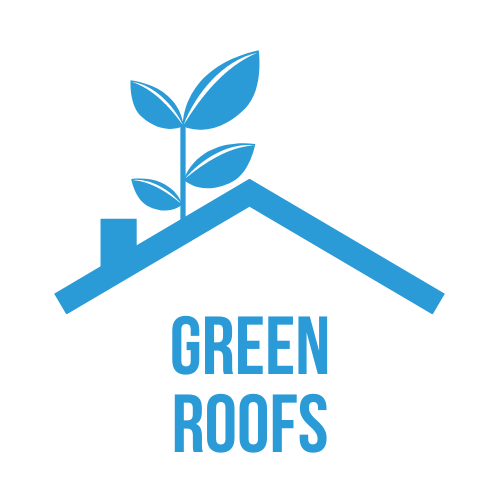urban CONSERVATION practices
Urban conservation is practiced on a small-scale by individual homeowners and also on a much larger scale but businesses and municipalities. It has expanded significantly in the past decade as more Iowans who live and work in cities and suburbs have become interested and engaged in stewardship projects and activities. Many of the larger urban conservation projects are aimed at improving and protecting water quality.
Urban areas have many impervious surfaces, such as streets, rooftops, parking lots, etc., which can’t soak up rain. During storms, rainwater and pollutants drain off these surfaces to storm drains, which ultimately flows to streams and lakes. Stormwater also damages stream channels, pollutes water sources and causes flooding.
Residential and urban landscapes generate runoff with almost every rainfall event. Conservation measures, many of which are highlighted in the Homeowner’s Guide to Stormwater Management brochure, capture and infiltrate stormwater and reduce a property's contribution to water quality degradation, flashy stream flows and flooding.
Communities benefit from urban conservation in installing new systems and retrofitting existing infrastructure so that water will be captured and treated as it moves off streets, keeping soil and pollutants out of our waterways. By implementing Iowa Stormwater Management Manual guidelines and principles, which are outlined in the the Stormwater Strategies for Communities brochure, communities of all sizes can improve water quality and reduce water quantity challenges.
Helping homeowners and urban landowners improve water quality
In Iowa, rainfall averages anywhere from 28-36 inches per year. An acre of land, in town or the country, will receive anywhere from 760,000 to 977,500 gallons of rain in a typical year.
Current storm water management efforts focus on moving the water away as quickly as possible. The result is litter and pollutants being washed into a storm drain and being carried to the nearest river, lake or stream during each and every rainfall. It also creates rushes of water that result in dramatic changes in stream levels that contribute to stream bank erosion and even flash flooding.
It is important for all Iowans to take steps to better manage the rain that falls on their property, with a focus on preventing runoff and promoting infiltration. One step is to use the Unified Sizing Criteria, a comprehensive approach to stormwater management systems, which uses measurement standards to meet flooding, health, safety and water quality goals. These criteria are used to design these best management practices that meet desired treatment objectives. See the Unified Sizing Criteria brochure for more information.
The practices listed below are the best practices for preventing runoff and promoting infiltration.
write
Contact US
To reach the Urban Conservation team with general inquiries, or to be added to our email list for the latest updates on ISWMM guidelines and current activities, please call one of the individuals below or email urbanconservation@iowaagriculture.gov
Ann Seda
Des Moines, Southwest Iowa
515-725-0150Kaitlyn Wagner
Storm Lake, Northwest Iowa
712-732-3096 x309
Paul Miller
Statewide
515-281-5833Jennifer Welch
Ankeny, Central Iowa
515-776-4237Amy Bouska
Iowa City, Eastern Iowa
319-499-4841
CLICK BELOW FOR MORE INFO & RESOURCES
IDALS Design and Maintenance Resources
Bioretention Cell
ISWMM Chapter, Design Checklist, Maintenance Guide
Planter Box
ISWMM Chapter, Design Checklist, Maintenance Guide
Bioswale
ISWMM Chapter, Design Checklist, Maintenance Guide
Native Seeding
ISWMM Chapter, Design Checklist, Maintenance Guide
Native Live Plant
ISWMM Chapter, Design Checklist, Maintenance Guide
Native Turf
ISWMM Chapter, Design Checklist, Maintenance Guide
Permeable Pavers
ISWMM Chapter, Design Checklist Single Practice, Maintenance Guide
Design Checklist Multiple Practices, Design Checklist Detention
Basic Rain Garden
ISWEP Rain Garden Guide, Design Checklist, Maintenance Guide
Enhanced Rain Garden
ISWEP Rain Garden Guide, Design Checklist, Maintenance Guide
Rainwater Harvesting
Design Checklist, Maintenance Guide
Stormwater Wetland
ISWMM Chapter, Design Checklist, Maintenance Guide
Streambank Stabilization
Design Checklist, Maintenance Guide
Soil Quality Restoration
ISWMM Chapter, Design Checklist, Maintenance Guide
Wet Detention Pond
ISWMM Chapter, Design Checklist
Extended Dry Detention Pond
ISWMM Chapter, Design Checklist
Green Roofs
ISWMM Chapter, Design Checklist
ADDITIONAL Resources
NRCS Native Prairie Management Guide and Seeding Calculator
Iowa Rain Garden Design and Installation Guide
Iowa River Restoration Toolbox
Soil Quality Restoration Frequently Asked Questions
Stormwater Management Plan Template
Stormwater Design & Supporting Document Checklist
ISWMM Design Standards Specifications
Assessing Urban Watersheds in Iowa: A Technical Resource Guide for Communities and Consultants




